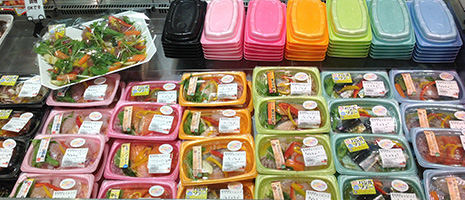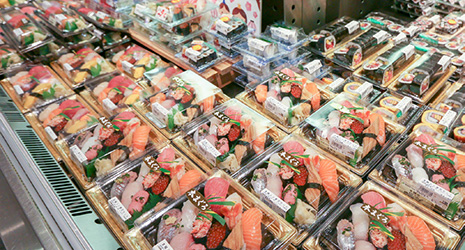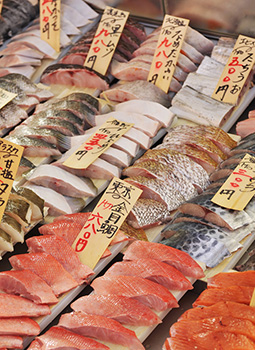Home > Highlighting JAPAN > Highlighting Japan April 2018 > The Maritime Nation of Japan
Highlighting JAPAN


Fish-Loving Food Culture Refreshed
Consumption of fish has been declining in Japan in recent years, but one seafood dealer is nevertheless enjoying strong sales growth while promoting a variety of ways to enjoy eating fish.
Fish and fishery products have comprised much of the Japanese diet for centuries, as the country is surrounded by the sea and blessed with a wealth of various marine products all year round. Seafood is processed by Japanese people using many different traditional recipes that include fermenting it to make nare-zushi (fermented sushi), which is believed to be the earliest form of today’s sushi; drying and salting it to preserve the fish; and pureeing it to form fish cakes. Fish is served raw as sashimi or sushi, fried as in tempura, grilled, simmered and steamed, and it has played a significant role as an ingredient in making Japanese food culture so rich and diverse.
After the Second World War, the consumption of fish and fishery products in Japan began growing as development of transportation distribution networks and household refrigerators made fresh marine products accessible to consumers living in the mountainous countryside as well. According to the White Paper on Fisheries published by the Fisheries Agency, the annual consumption of fish and fishery products per capita in Japan was 40.2 kg in FY2001. (The annual consumption of meat per capita in Japan was 27.8 kg in the same year.)
However, the domestic consumption of fish and fishery products peaked in FY2001 and declined steadily in the following years to a low of 25.8 kg in FY2015. The downward trend in the consumption of fish and fishery products could be attributable to factors such as food diversification, a reduction in domestic fishing capacity, and consumers’ growing reluctance to take the time needed to prepare fish dishes, given the aging population along with an increase in the number of working families.
Despite the challenging trends in the market, Toshin Sea Foods Co. trades over 200 types of fish and fishery products a year and is enjoying strong sales growth. The company was founded in Ogikubo, Tokyo in 1949 and now operates thirty retail shops primarily in the Tokyo metropolitan area, offering a variety of opportunities for consumers to become familiar with fish and fishery products.
Nobutsune Orimo, President of Toshin Sea Foods Co., says, “People cook fish at home much less often than in the past because they do not know how to cook fish, or cooking fish takes up too much of their time. We are attempting to develop new fish products and related services in response to consumer needs as indicated by their reasons for not cooking fish at home.”
Toshin Sea Foods Co. is not just a fish trader. It actively promotes opportunities for consumers to become familiar with the fun of eating fish and fishery products in pursuing quality of life. As part of its initiatives, the company opened Toshin Kitchen at its Ogikubo main store in 2014.
At seafood retailers, shop clerks do not usually tell their customers how to cook fish. At Toshin Kitchen, a professional chef gives cooking demonstrations three times a day (morning, afternoon and evening) in a fully equipped kitchen facility including a cooking heater, a microwave oven and a cooking counter.
The customers who visit Toshin Kitchen have different profiles and preferences depending on the time of day when they visit the facility. The chef tries to avoid redundancy in the dishes demonstrated during the day by introducing fish dishes that originate not only from Japanese cuisine, but also from Italian and Chinese cuisine. For example, the chef introduces dishes for large, low-cost food for housewife customers who visit with their children in the afternoon, and easy-to-cook dishes for working families and single office workers who visit the facility in the evening.
“Toshin Kitchen offers easy-to-cook recipes for fish dishes that encourage our customers to cook fish at home. Our persistent efforts to overcome the stereotypical image that cooking fish is complicated have finally paid off, and we have succeeded in attracting more customers to visit our shops more often,” says President Orimo.
Along with the activities carried out at Toshin Kitchen, the company has developed easy-to-prepare precooked fish products, offering packaged sushi and sashimi as well as ready-to-eat microwave meal products in all of its retail stores. The colors of the food trays have been changed from black or white to yellow, blue or pink, as the colorful food packages were well received by customers, who say the dish on the table looks delicious and cheerful.
The company focuses on human resources development initiatives, and actively hires women and foreign nationals. In January 2018, the company hired ten trainees from Vietnam for the first time. The Vietnamese trainees have acquired hands-on skills in filleting, cooking and selling fish and fishery products. They now work in retail stores. The company plans to hire around ten trainees from Vietnam every year.
“We would like to pass Japanese cultural traditions and skills regarding fish onto the trainees. I hope that they will contribute to enriching their food culture when they are back in Vietnam, leveraging the skills and expertise in fish that they have acquired in Japan,” Orimo says.
Japan is not the only fish-loving country in the world of course. Toshin Sea Food Co. hopes that its initiatives will be helpful in enabling the Japanese food culture to be passed onto the next generation both in Japan and abroad, enriching fish-loving food cultures around the world in many ways.
© 2009 Cabinet Office, Government of Japan








